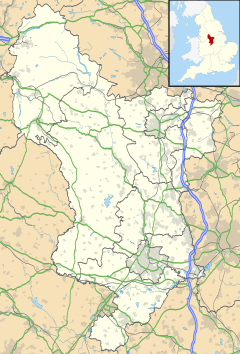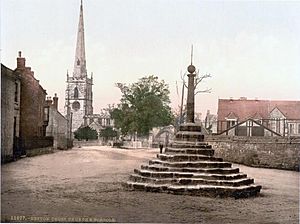Repton facts for kids
Quick facts for kids Repton |
|
|---|---|
St Wystan's parish church |
|
| Population | 2,707 (2001 census) |
| OS grid reference | SK3026 |
| District |
|
| Shire county | |
| Region | |
| Country | England |
| Sovereign state | United Kingdom |
| Post town | Derby |
| Postcode district | DE65 |
| Dialling code | 01283 |
| Police | Derbyshire |
| Fire | Derbyshire |
| Ambulance | East Midlands |
| EU Parliament | East Midlands |
| UK Parliament |
|
| Website | Repton Village Website |
Repton is a historic village in Derbyshire, England. It sits near the River Trent, about 5 miles (8 km) north of Swadlincote. In 2011, about 2,867 people lived here. Repton is also close to the border with Staffordshire.
This village is famous for several important places. These include St Wystan's Church and Repton School. It also has links to the old Anglo-Saxon Repton Abbey and the medieval Repton Priory.
Contents
A Look at Repton's Past
Christianity first came to the Midlands in Repton. Some members of the Mercian royal family were baptised here in AD 653. Soon after, a special abbey was built for both monks and nuns.
In 669, the Bishop of Mercia moved his main church from Repton to Lichfield. Later, King Offa of Mercia wanted his own church leader. He created the Archdiocese of Lichfield. This new archdiocese covered a large area of England.
Repton was thus very important in the early English church. However, this special arrangement only lasted 16 years. Mercia then returned to being under the Archbishop of Canterbury.
Viking Winter Camp
The Anglo-Saxon Chronicle tells us that the Great Heathen Army stayed in Repton during the winter of 873–74. This was a large group of Viking warriors.
People first found signs of Vikings in Repton in the late 1600s. A worker found a pit of bones in a garden. Later, a special Viking tombstone was found in the churchyard.
Between 1974 and 1988, archaeologists Martin and Birthe Biddle led big digs. They found a D-shaped earthwork near the River Trent. They thought this was the Viking camp.
More recently, new digs started in 2015. Cat Jarman and Mark Horton used special radar to find more hidden structures. They found grave sites with bones and old stone pieces.
The Biddles also found a large mound with a mass grave. It held the remains of at least 264 people. They believed these were linked to the Viking army. Old coins found there matched the 873–74 winter date.
An old story from the 1700s describes what was found in the mound. A worker found a "nine foot tall" skeleton in a stone coffin. Other human bones were neatly stacked around it.
St Wystan's Church: A Special Place
St Wystan's Church, Repton is famous for its Anglo-Saxon crypt. This crypt was built in the 8th century. It was a burial place for the Mercian royal family.
Who was Saint Wigstan?
Wigstan, also known as Wystan, was a Mercian prince. He was killed in 849. His body was buried in the crypt at Repton. People believed miracles happened there.
Repton became a place where people went on pilgrimage. Wigstan later became a saint. He is now the patron saint of the church.
The 8th-century crypt was the first burial place of Saint Wigstan. His grandfather, King Wiglaf, was also buried there. King Æthelbald, who first built the crypt, was also laid to rest here.
After Saint Wigstan was buried, the crypt became a holy shrine. It was a very important place for visitors.
Church Design and Changes
Some experts think the crypt at Repton influenced later church designs. It might have inspired parts of Westminster Abbey. This includes the shrine of Edward the Confessor.
The church itself has been changed many times. Medieval Gothic aisles were added in the 13th century. The west tower and tall spire were built in 1340. The church was also repaired and updated in the late 1800s.
Famous People from Repton
Many notable people have connections to Repton:
- King Æthelbald of Mercia was buried here in 757.
- Beornred of Mercia was also buried here.
- Russell Osman, a famous footballer, was born here in 1959.
- King Wiglaf of Mercia was buried in Repton.
- Basil Rathbone, a well-known actor, lived here as a child.
- Saint Wigstan of Mercia was buried here first.
- Walter Somers, an engineer, was born in Repton in 1839.
- Elsie Steele (1899–2010), who was once the oldest person in Britain, lived her last years here.
Gallery
-
Thatching in progress, May 2007
-
Crypt at St Wystan's Church








